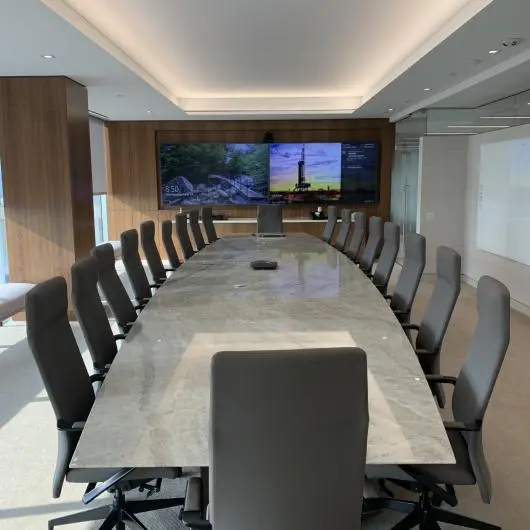The meetings can get stale as the conference room tech battles against the room tech. If you’ve ever used the conference room presentation systems you’ve probably faced spinning wheels, blank screens or speakers that aren’t working in the most opportune time. What’s good? The majority of problems are traced back to a few predictable problems that can be avoided by implementing smart configuration and easy steps.
Issue 1: Cable Chaos & Connectivity
Why it Happens
Cables break, adapters disappear and laptops come with every port you can imagine under the sky. Include the loose grommets from tables and you’ve got yourself a dish that can be used to ask “Can anyone see my screen?”
Quick Fixes
Make sure you have a limited selection of high-quality certified cables (HDMI as well as USB-C). Choose a tabletop hub which has clearly marked inputs. Attach everything to the table using under-table raceways, so that there are no “walks.”
Issue 2: Display Mismatch & Resolution Errors
Typical Symptoms
When you connect… your screen is flickering, your image grows and fonts appear blurry. It’s usually an EDID error or scaling issue in the connection between source and display.
How to Resolve
Set display settings to lock in the extender or switcher. Select a house resolution (e.g. 1080p/60) which most laptops can happily output. Make sure to keep a 4K path when required, but make sure that downscalers have been installed to support older equipment.
Issue 3: Audio Headaches
Echo, Hum, and Feedback
Echo typically means that the high-end audio has slipped back into the microphones. It could indicate grounding issues or cabling problems.
Speech Clarity
Set mics nearer to talking devices (ceiling tiles can make magic with mics). Make use of DSP using Acoustic echo cancellation as well as noise reduction and an appropriate gain structure. Set levels to calibrate; the majority of “tinny” sound is just bad EQ.
Issue 4: Wireless Screen-Sharing Glitches
Interference & Bandwidth
The congested 2.4 bands at 2.4GHz and poor positioning of APs cause wireless sharing to stop. You should choose five GHz (or Wireless-Fi 6) and provide the sharing device an electrical uplink whenever you can.
Guest Access & Security
The guests must be present and not touching the secure network. Make use of an external guest SSID or an isolated VLAN and activate PIN/Code Connect. Note the steps of joining with a quick one-pager on the display.

Issue 5: Confusing Control Interfaces
UX Pitfalls
If the users have to face the wall of small buttons, they’ll hit the entire panel. The over-flavoured touchscreens slow down meetings.
Training & SOPs
Make a home screen which reads, “Tap to Present.” Include three options: “Share Laptop,” “Join Call,” “conference room Off.” Make sure to keep the laminated card for quick-start placed on the table, along with one 60-second clip within the QR code of your conference room.
Preventive Maintenance Checklist
Weekly Checks
The devices should be powered off during the day and verify the inputs, check the wireless and wired share as well as run a 30 second microphone/speaker test.
Monthly Checks
Check cables, wipe panels and confirm firmware versions as well as export device configs to an encrypted backup.
Firmware & Driver Updates
Don’t be shocked by schedule updates. The CEO’s call to the board. Changes to the stage in a test area first.
Design Best Practices Right from the Beginning
BYOD Readiness
Make sure you support the laptop they bring and not the laptop you would like to have. Make sure that USB-C has the power supply, HDMI along with a stable USB route for your cameras and microphones.
Network Segmentation & QoS
Place AV devices in the isolated VLAN and prioritize the real-time media. This avoids the “why did the call freeze when marketing uploaded a video?” time.
When to Call a Pro
If you’re dealing with complicated routes, multi-display conference room, or other compliance needs, call experts who are certified to integrate. Regional specialists understand common building quirks and local support expectations–searching for video conferencing Houston is a smart way to find teams with nearby parts, rapid dispatch, and proven playbooks.
Conclusion
The technology in your conference room should not be a problem. Manage cabling, make resolutions uniform as well as tune your audio, harden wireless, and streamline controls. Finally, add light periodic maintenance. When you’ve done that, your meetings will start punctually and presenters remain calm while the equipment fades away into the background, exactly the place it should be.
FAQs
What can I do to reduce the time it takes to set up presenters?
Give only one “bring-your-own” hub with USB-C as well as HDMI as well as a transparent Quick-Start card that you can place on your table.
What’s the simplest audio enhancement for smaller conference room?
Switch the TV’s speakers to the soundbar built with DSP and then add the tabletop microphone puck.
How can I improve the reliability of wireless sharing?
Make sure the appliance is connected to the option of a wired network and preferably 5 GHz or Wi-Fi 6, and make sure that channels are free of congestion.
What should I do to stay clear of unexpected surprises at the last minute before major gatherings?
Aim for a five-minute pre-flight. Connect your laptop, then share slides, test for speakers and mics, check the camera’s frame.
Does 4K really make sense to use for spreadsheets and slides?
The majority of times, 1080p is adequate for content with a lot of text; save the 4K resolution for design-related review spaces or big displays that can be viewed from close up.




